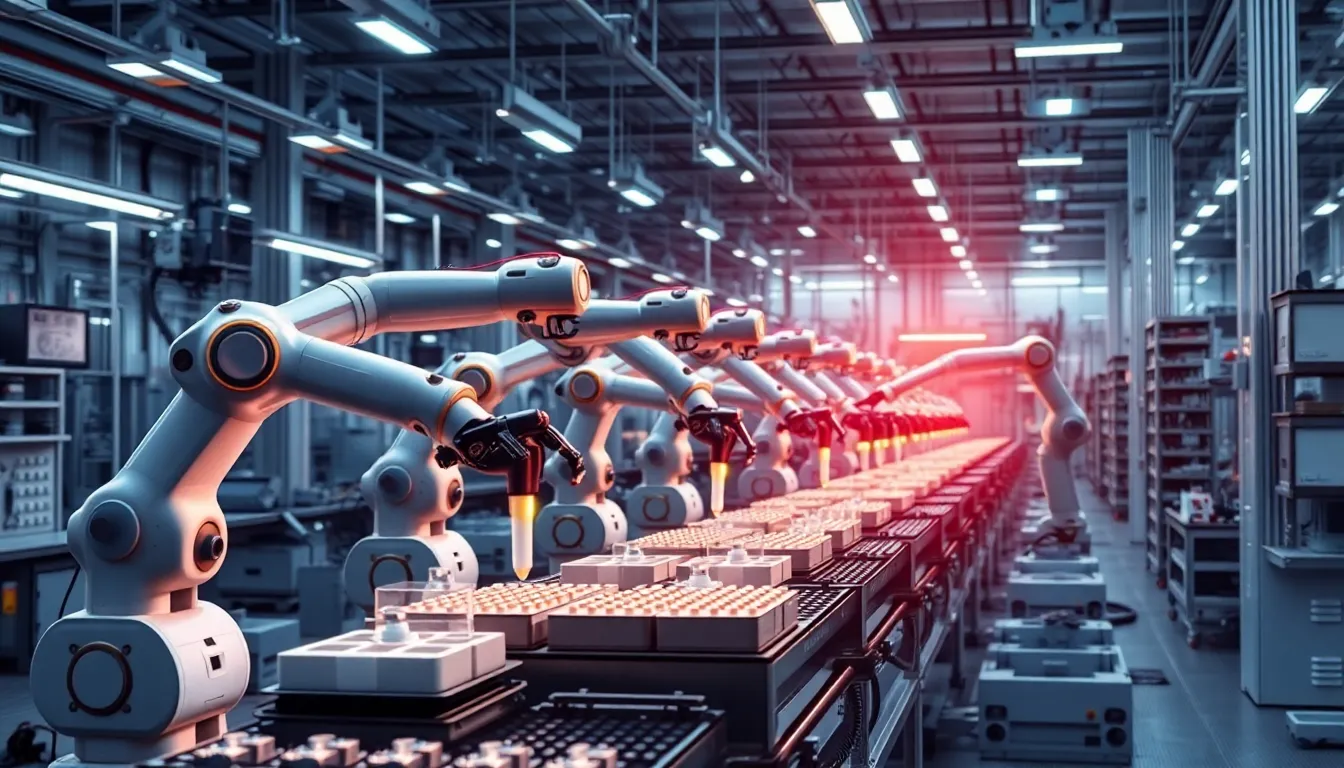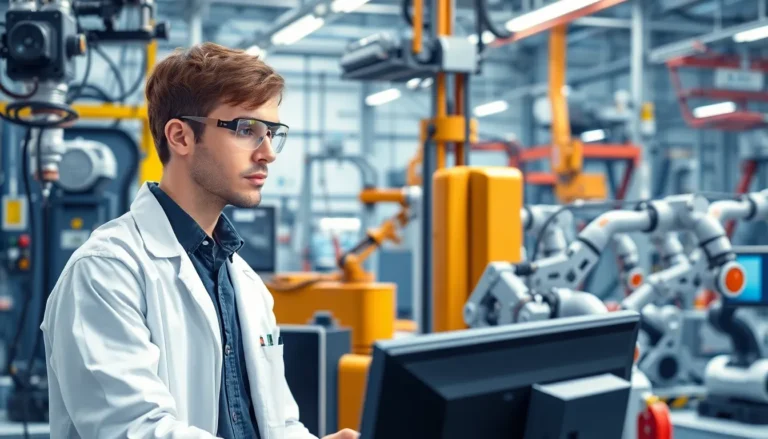In a world where robots are no longer just the stuff of sci-fi movies, robotics manufacturing is revolutionizing how products are made. Imagine a factory floor buzzing with machines that not only work tirelessly but also never complain about coffee breaks. This isn’t just a dream; it’s the future of manufacturing, and it’s happening right now.
As industries scramble to keep up with demand, robotics is stepping in like a superhero with a spanner. From assembling complex electronics to crafting the perfect car, these mechanical marvels are enhancing efficiency and precision. So, if you think robots are just for delivering pizza or vacuuming your living room, think again. The age of robotics manufacturing is here, and it’s time to embrace the change—because who wouldn’t want a robot buddy that actually knows how to get things done?
Table of Contents
ToggleOverview of Robotics Manufacturing
Robotics manufacturing represents a vital component of modern industrial processes. These systems streamline production, enhance quality, and significantly reduce costs.
Definition and Importance
Robotics manufacturing involves the use of robotic systems to automate tasks within production environments. This automation increases efficiency and precision across various industries, from automotive to electronics, contributing to lower production costs. Companies relying on robotics achieve improved quality control, minimizing errors often associated with manual labor. The importance of robotics lies in its ability to meet rising consumer demands while enhancing workplace safety by taking on dangerous tasks. It enables manufacturers to maintain competitiveness in an evolving market.
Current Trends
Current trends in robotics manufacturing show rapid advancements in artificial intelligence and machine learning integration. Automation is becoming more flexible and adaptive, allowing robots to perform multiple tasks with minimal reprogramming. Collaborative robots, or cobots, are increasingly commonplace, working alongside human operators in a shared workspace. Manufacturers are also investing in IoT (Internet of Things) technology, enabling real-time data collection and analysis to optimize operations. The trend towards customization further emphasizes the importance of robotics in adapting to specific production requirements seamlessly.
Benefits of Robotics Manufacturing

Robotics manufacturing offers numerous advantages that significantly enhance production processes. Organizations utilize robotic systems for various functions, leading to impactful outcomes.
Increased Efficiency
Efficiency increases as robots consistently perform tasks at high speeds. Operations that may take hours for human workers can be completed in minutes by robots. These machines work non-stop, reducing downtime and maximizing productivity across production lines. Automation allows for the simultaneous handling of multiple tasks, leading to a seamless flow of operations. Manufacturers witness heightened output, enabling them to respond swiftly to market demands and maintain competitiveness.
Cost Reduction
Cost reduction occurs due to decreased labor costs and improved operational efficiency. Employing robots lessens the need for a large workforce, allowing manufacturers to reallocate resources effectively. Errors in production decrease, minimizing waste and rework expenses. Long-term savings also arise from lower energy consumption and maintenance costs. Investment in robotics yields a significant return as companies streamline operations, ultimately driving profitability.
Improved Quality
Quality improves through robotic precision and consistency in manufacturing processes. Robots consistently execute tasks with minimal errors compared to human counterparts. Enhanced quality control measures are implemented, ensuring products meet stringent standards. Automated inspections identify defects faster, allowing timely interventions. With reduced variability, manufacturers deliver superior products, satisfying customer expectations and fostering brand loyalty.
Key Technologies in Robotics Manufacturing
Robotics manufacturing relies on several key technologies that drive automation and enhance productivity. These technologies play a vital role in modern manufacturing processes.
Industrial Robots
Industrial robots represent the backbone of robotics manufacturing. They often perform repetitive, high-precision tasks like welding, painting, and assembly. Equipped with advanced sensors, these robots adapt to various production scenarios while maintaining efficiency. The flexibility of industrial robots enables manufacturers to adjust configurations quickly, responding to changing demands without significant downtime.
Machine Learning and AI
Machine learning and artificial intelligence are transforming robotics manufacturing. By analyzing data from the production line, these technologies improve decision-making and enhance operational efficiency. Robots equipped with AI can predict potential issues and adjust processes proactively, minimizing waste and maximizing productivity. This intelligent integration allows for continuous learning and improvement in manufacturing operations, aligning with the fast-paced market requirements.
Automation Systems
Automation systems streamline workflows in robotics manufacturing. They integrate various robotic components, sensors, and software platforms to facilitate seamless communication and task coordination. These systems help optimize production schedules and resource allocation while reducing human error. As a result, manufacturers achieve greater consistency and quality in their output, making automation systems essential for modern production environments.
Challenges in Robotics Manufacturing
Robotics manufacturing faces several significant challenges that can impede progress and adoption.
High Initial Investment
High initial investments represent a major barrier in robotics manufacturing. Many manufacturers find the cost of robotic systems daunting, often amounting to hundreds of thousands of dollars. Smaller companies particularly struggle with budgeting for such significant expenses. These costs encompass not just the robots but also installation, training, and maintenance. Many manufacturers hesitate to adopt robotics due to uncertainty about return on investment. Long-term benefits, however, may outweigh initial financial outlays, as productivity gains and reduced labor costs can lead to substantial overall savings.
Skills Gap in Workforce
Skills gaps in the workforce create another pressing challenge in robotics manufacturing. Many current employees lack the necessary training to work effectively with advanced robotic systems. The rapid evolution of technology demands a workforce skilled in programming and maintaining these complex machines. Companies struggle to find qualified individuals who can adapt to robotic innovations. Closing this skills gap requires ongoing training programs and educational initiatives. Partnerships with educational institutions can help ensure a steady pipeline of skilled labor familiar with the latest robotics advancements.
Future of Robotics Manufacturing
The future of robotics manufacturing looks promising, ripe with advancements and transformation potential. As industries evolve, innovations on the horizon will further streamline processes, enhance capabilities, and redefine productivity.
Innovations on the Horizon
Emerging technologies significantly shape the landscape of robotics manufacturing. Next-generation artificial intelligence will enhance robots’ adaptability, making them increasingly capable of handling complex tasks. Collaborative systems will improve human-robot interaction, creating safer and more efficient working environments. Furthermore, advanced sensors will enable robots to gather real-time data, optimizing operational efficiency. Automation solutions integrated with IoT will facilitate predictive maintenance and smart factory concepts. Organizations that embrace these innovations can expect to see heightened productivity and increasingly sophisticated production lines.
Impact on Employment
The rise of robotics manufacturing brings both opportunities and challenges for the workforce. Automated systems often handle repetitive tasks, leading to concerns about job displacement. In contrast, new roles will emerge, emphasizing advanced skills in machine operation, programming, and maintenance. Upskilling workers will become essential to adapt to evolving technology. Manufacturers may invest in training programs designed to close the skills gap. Creating a partnership with educational institutions can help develop talent familiar with robotics. These efforts can lead to a more skilled workforce equipped to thrive in an automated environment.
The landscape of robotics manufacturing is rapidly evolving and reshaping production processes across industries. As companies embrace automation, they’re not only enhancing efficiency but also ensuring higher quality standards and improved safety measures. The integration of advanced technologies like AI and IoT is driving innovation and adaptability in manufacturing environments.
While challenges such as high initial costs and workforce training remain, the potential benefits far outweigh these hurdles. By investing in robotics, manufacturers position themselves to meet growing consumer demands and maintain a competitive edge. The future of robotics manufacturing holds exciting possibilities, paving the way for smarter factories and a more skilled workforce.




